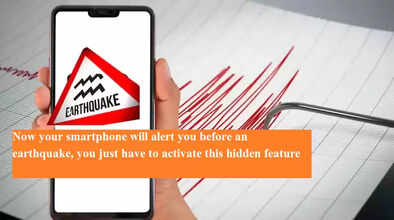Now your smartphone will alert you before an earthquake, you just have to activate this hidden feature

Your Android Smartphone Can Now Warn You of Earthquakes Before They Strike – Here’s How to Enable It
Natural disasters like earthquakes cannot be prevented, but timely alerts can help save lives and minimize damage. Traditionally, disaster management teams issue warnings to keep people safe. Now, your Android smartphone can play a critical role too. Thanks to a feature developed by Google, Android phones can detect early signs of earthquakes and send instant alerts, giving you valuable seconds to act.
Earthquake Alerts Feature Arrives in India
Google first introduced its Android Earthquake Alerts System in 2020. After proving successful in several countries, the feature was officially rolled out in India in July 2025. Since its launch, the system has detected over 2,000 earthquakes worldwide.
One of its most notable achievements came in 2023 when it successfully identified a 6.7 magnitude earthquake in the Philippines. The system sent alerts to nearly 2.5 million people in time to take precautionary action. While Google admits the system isn’t perfect yet, the company continues to refine and improve its accuracy.
How Does the Earthquake Alert Work?
The technology is built on a small but powerful sensor already inside every Android smartphone—the accelerometer. Normally used to track steps in fitness apps or change screen orientation when you rotate your phone, this sensor can also act as a mini seismometer.
Here’s how it works:
-
When your phone detects unusual shaking consistent with an earthquake, the accelerometer records the movement.
-
The phone then sends location and vibration data to Google’s servers.
-
If multiple devices in the same area report similar tremors, Google confirms an earthquake event.
-
The system then sends an alert notification to smartphones in the affected region, sometimes seconds before the stronger tremors arrive.
This early warning system can give people enough time to move to safer places, reducing risks during emergencies.
Different Alerts Based on Earthquake Intensity
Google’s system issues alerts based on the magnitude of the earthquake:
-
For quakes around magnitude 4.5, users receive a “Be Aware” alert, advising caution.
-
For stronger earthquakes, the system issues “Take Action” alerts, urging users to seek immediate safety—such as moving outdoors or taking cover under a sturdy table.
These instant warnings can mean the difference between safety and injury during sudden seismic activity.
How to Enable Earthquake Alerts on Your Android Phone
In many newer Android devices, the feature is enabled by default. However, if it isn’t active on your phone, you can turn it on manually with just a few steps:
-
Open your phone’s Settings.
-
Scroll down and tap on Safety & Emergency.
-
Select Earthquake Alerts.
-
Toggle the switch to On.
Keep in mind that your phone’s location services and internet access must be enabled for the alerts to work properly.
Why This Feature Is Important for India
India is among the most earthquake-prone countries in the world, especially in regions like the Himalayan belt, northeastern states, and parts of northern India. With dense populations in many high-risk areas, even a few seconds of advance warning can significantly reduce casualties and property damage.
By turning millions of Android smartphones into a nationwide earthquake detection network, Google’s system offers an additional layer of safety. It also reduces reliance solely on traditional seismic monitoring systems, which may not always reach people in time.
Conclusion
Google’s Android Earthquake Alerts system represents a powerful example of how AI and everyday technology can help protect lives. By using sensors already present in smartphones, Google has transformed ordinary devices into tools for disaster preparedness.
If you own an Android phone in India, it’s worth ensuring that this feature is enabled. Those precious extra seconds of warning during an earthquake could make all the difference.

